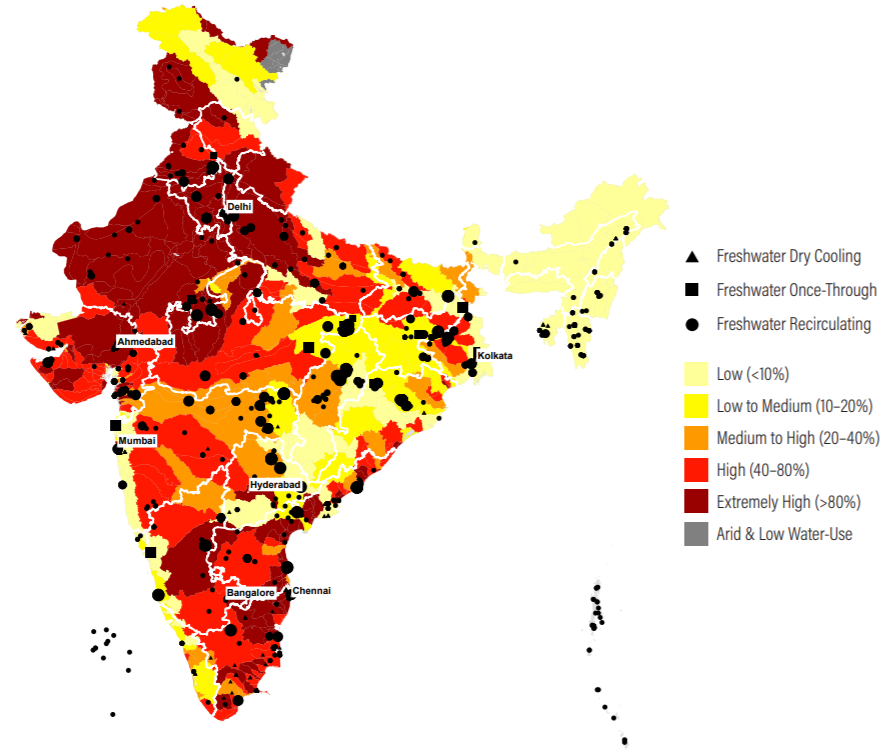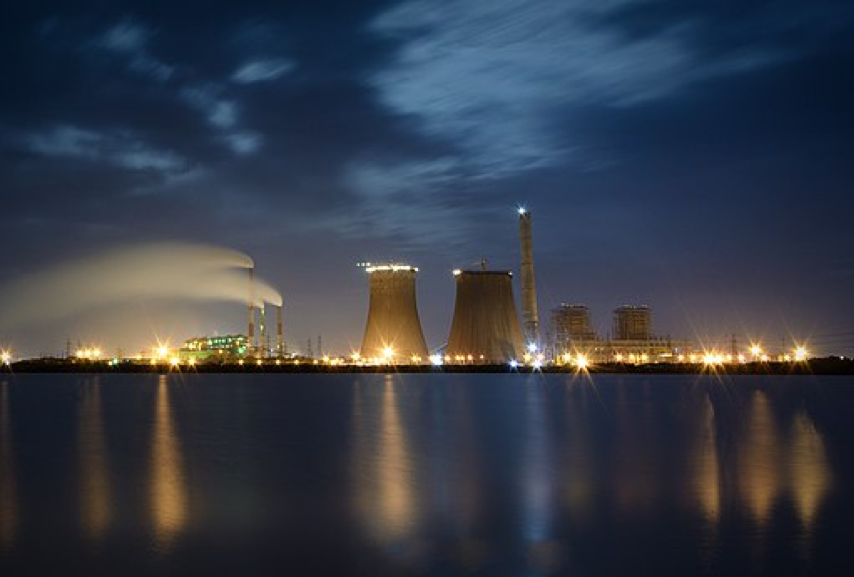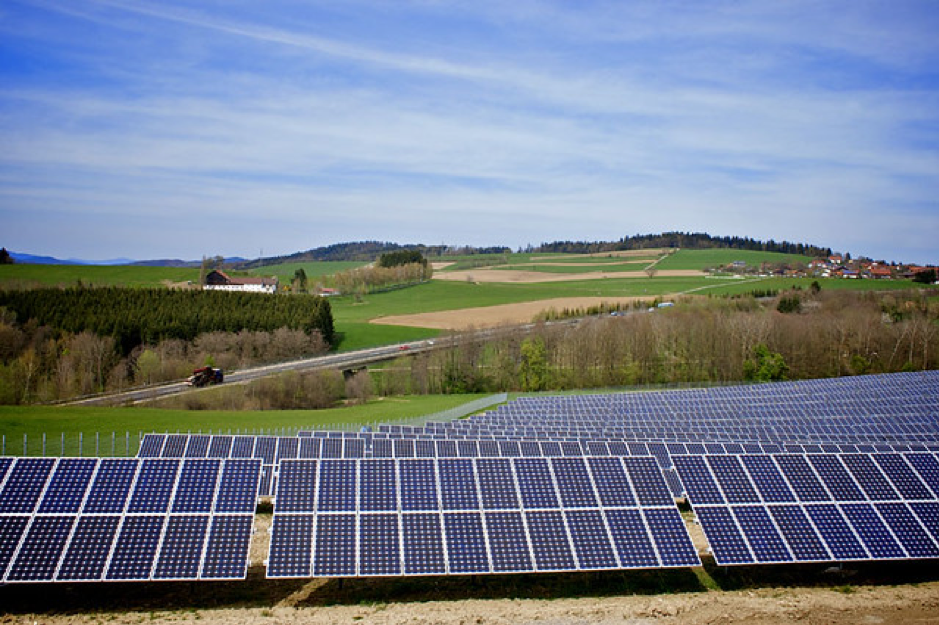How can India better regulate the water consumption of its thermal power plants?
As India awaits monsoons, many parts of the country are already reeling under drought-like conditions. The government, private agencies and even residential associations are issuing directives and messages, highlighting the need for water conservation and the parsimonious use of water. Thermal power plants in the country constitute a class of water users that is often overlooked.
Thermal power plants consume significant amounts of water during their process of generating electricity. A WRI report found that most of India’s thermal power plants today are located in water-stressed areas, and water shortages have led to electricity generation disruptions and significant revenue losses for the economy.
 Figure i - India’s Freshwater-Cooled Thermal Utilities Mapped against Baseline Water Stress and Distribution in Installed Capacity by Water Stress Level by State1
Figure i - India’s Freshwater-Cooled Thermal Utilities Mapped against Baseline Water Stress and Distribution in Installed Capacity by Water Stress Level by State1
With the generation of electricity imposing such a heavy burden on the country’s stressed water resources, water usage in thermal power plants require stringent regulation. In December 2015, the Ministry of Environment Forest and Climate Change (MoEFCC) issued a notification setting limits for air pollution and water consumption by thermal power plants for the first time. After a delay of over two years, in June 2018, these environmental norms were incorporated in the legal framework, through an amendment to the Environment (Protection) Rules, 1986 (the “EP Rules”) issued under the Environment Protection Act (“the EP Act”). However, the amended EP Rules diluted the limits for water consumption that were originally proposed, permitting thermal power plants to use more water than was initially notified.
This blog will delve into some of the crucial aspects which must be strengthened for these regulations to be effective.
The Reporting Mechanism for Water Consumption
The Central Electricity Authority (CEA) recently released the format for thermal power plants to disclose information about their water consumption for each financial year. These include the annual actual water consumption (metered and un-metered), the type of water source used (river, canal, sea, etc.), and the percentage of deviation from the water norms along with reasons and corrective measures undertaken.
These guidelines can be strengthened by including other relevant inputs. First, the thermal power plants should be required to disclose the amount of water consumed by them in previous years, so that a baseline for water consumption per thermal power plant can be established, and the success of each thermal power plant in reducing its water consumption can be quantified. Second, it is essential for these reporting requirements – which are currently in the form of an Excel sheet uploaded on the CEA website - to be formally made a part of the law, to accord the disclosure process greater transparency and enforceability. Last, the disclosure requirements should include a requirement for submitting verifiable evidence (for example, water bills) to support and substantiate the disclosures. Without these, the self-reporting guidelines will remain weak.
 Figure ii - Representational Image of a thermal plant in Tamil Nadu, India (Ramkumar/Flickr)
Figure ii - Representational Image of a thermal plant in Tamil Nadu, India (Ramkumar/Flickr)
The data generated by thermal power plants through the newly-introduced disclosure requirements should be made easily available, so that the parameters disclosed by thermal power plants can be studied in the context of region-specific water shortages, outages in thermal power plants, etc. The CEA could establish an online portal where the information submitted by the thermal power plants can be accessed. India’s water scarcity is an important focus area, and future research and analysis in this field must be founded on transparent and reliable data.
Improving Enforcement
As mentioned above, the norms for air pollution and water used by thermal power plants were issued under the EP Act. Section 15 of the EP Act provides for a blanket penalty for contravention of any provisions of the EP Act or EP Rules: imprisonment of up to five years and/or a fine of upto one lakh rupees along with additional fines per day for continuing offences. The EP Act does not provide specific penalties for specific offences. Perhaps this is an area for review by the government, so that we have a more nuanced framework for enforcement and penalties. Further, the relevant officials in charge of enforcement– across the MoEFCC and the CEA - should be clearly identified, and their roles well-defined. The implementation of these norms should include milestones and time-based targets, and the monitoring should include periodic assessments of the progress of thermal power plants in making technological improvements.
Enhance Renewable Energy Deployment
Even as India seeks to make the thermal power plants more water efficient, we need to consider how much more water stress from thermal power plants our country can afford. Simultaneously, we should turn to less water consuming renewable energy technologies.
 Figure iii - Representational Image (Windwärts Energie/Flickr)
Figure iii - Representational Image (Windwärts Energie/Flickr)
In addition to reducing the stress caused by thermal power plants, shifting to a more aggressive renewable energy pathway will help India achieve its global climate targets. However, planning and deployment of an increased renewable energy future in India will need more work – crucially on reducing water consumption by specific renewable energy technologies. The Ministry of New and Renewable Energy (MNRE) has taken a first step by issuing a notice to all state governments on reducing the use of water in the cleaning of solar panels and exploring alternate mechanisms to ensure solar panels remain efficient.
With 4% of the world’s renewable water resources and about 18% of the world’s population, India is a country with high water stress. As of May 30, 2019, 43.4% of the country was affected by drought conditions. India will need to balance the needs of its growing economy with its heightening water stress. The stringent implementation of standards for judicious water use by thermal power plants, combined with the promotion of renewable energy and energy efficiency offer pathways for achieving these goals.
-
Sourced from Parched Power: Water Demands, Risks, and Opportunities for India’s Power Sector. ↩︎